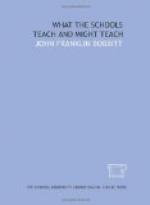As laid out in the manual now superseded, and as observed in the regular classrooms, the work has been forbiddingly formal. In the main it has consisted of the teacher assigning to the pupils a certain number of paragraphs or pages in the textbook as the next lesson, and then questioning them next day to ascertain how much of this printed material they have remembered and how well. It has not consisted of stimulating and guiding the children toward intelligent inquisitiveness and inquiring interest as to the world, and the skies above, and waters round about, and the conditions of nature that limit and shape the development of mankind.
That the latter is the proper end of geographical teaching is being recognized in developing the new course of study in this subject. Industries, commerce, agriculture, and modes of living are becoming the centers about which geographic thought and experience are gathered. The best work now being done here is thoroughly modern. Unfortunately it is not yet great in amount in even the best of the schools, still less in the majority. But the direction of progress is unmistakable and unquestionably correct.
As in the reading, so in geography, right development of the course of study must depend in large measure upon the material equipment that is at the same time provided. It sounds like a legitimate evasion to say that education is a spiritual process, and that good teachers and willing, obedient, and industrious pupils are about all that is required. As a matter of fact, just as modern business has found it necessary to install one-hundred-dollar typewriters to take the place of the penny quill pens, so must education, to be efficient, develop and employ the elaborate tools needed by new and complex modern conditions, and set aside the tools that were adequate in a simpler age. The proper teaching of geography requires an abundance of reading materials of the type that will permit pupils to enter vividly into the varied experience of all classes of people in all parts of the world. In the supplementary books now furnished the schools, only a beginning has been made. The schools need 10 times as much geographical reading as that now found in the best equipped school.
It would be well to drop the term “supplementary.” This reading should be the basic geographic experience, the fundamental instrument of the teaching. All else is supplementary. The textbook then becomes a reference book of maps, charts, summaries, and a treatment for the sake of perspective. Maps, globes, pictures, stereoscopes, stereopticon, moving-picture machine, models, diagrams, and museum materials, are all for the purpose of developing ideas and imagery of details. The reading should become and remain fundamental and central. The quantity required is so great as to make it necessary for the city to furnish the books. While the various other things enumerated are necessary for complete effectiveness, many of them could well wait until the reading materials are sufficiently supplied.




